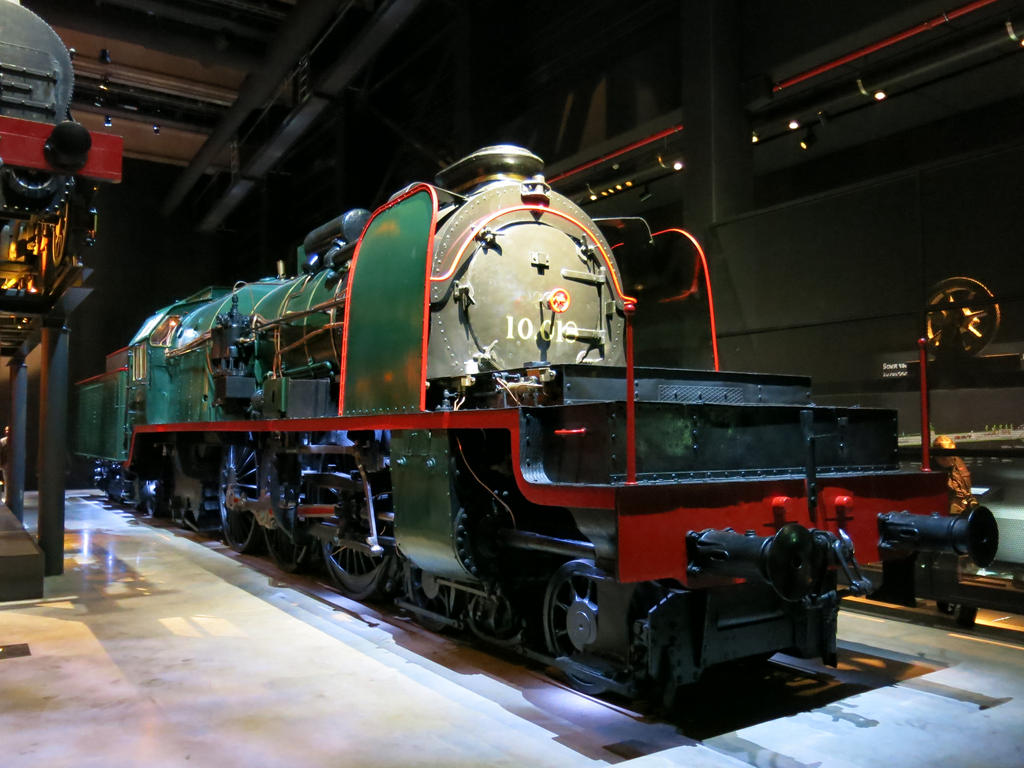ShopDreamUp AI ArtDreamUp
Deviation Actions

Royal Steam Fund
Support my continuous work by contributing to my tip jar. This tier won't include any specific perks, but you will receive my appreciation and a more regular upload schedule. Furthermore, your contribution will help me pay off a loan I had to take on for special medical treatment.
$5/month
Suggested Deviants
Suggested Collections
You Might Like…
Featured in Groups
Description
Schaarbeek/Schaerbeek station - TrainWorld, October 2nd 2015
In 1904, a golden decade would start for steam in Belgium. A number of developments would lead a great number of exceptional, and exceptionally powerful locomotives, which would go on to determine much of the Belgian Railways for the next half century.
In 1904, the Belgian Railways leased a French 4-6-0 compound locomotive, originally built for the Beijing-Han-k'ou railway, for trials on some of the network's most hilly lines. As a result of these trials, the Belgian State Railways decided to build compound locomotives of its own, with four cylinders built according to the De Glehn/Du Bosquet system as well as Belpaire fireboxes and Flamme bogies.
While the Type 9 already was a powerful engine in its own right, it was not powerful enough for the legendary Brussels-Luxembourg line - part of the London-Istanbul "Indian Mail" route, which in places had inclines of 16%. For that line, Flamme would design two legendary engines.
:origin()/pre01/d19e/th/pre/i/2015/278/3/2/schaarbeek_021015_trainworld_type_36_model_by_kanyiko-d9c2f0a.jpg)
The Type 36 of 1909 would be the heavy goods locomotive of the pair. A 104-tonne "Decapod", she was able to haul extremely heavy goods trains on the inclined Line 162.
For the passenger services, however, Flamme would design an equally remarkable machine: the Type 10 "Pacific" of 1910.
Both engines were designed to the most advanced technical standards of the type. They had the De Glehn/Du Bosquet system's four cylinders with simple expansion; Flamme's trademark steam superheaters; an expanded, conical "wagon top" firebox, all of which made the pair extremely powerful engines. While as a goods engine, the relatively small diameter of its wheels limited the Type 36's speed to just 65 kph despite its 1850 bhp, the Type 10's 2250 bhp and massive 1.98m diameter drive wheels gave it a top speed of 120 kph.
The Type 10's looks were made even more special by its relatively short boiler. As a result of this, the Type 10 had its cylinders set in front of its smoke box on either side of a 'platform' supported by the front bogey. While some might argue that this made the Type 10 look a bit 'ungainly', all would agree it did give her a 'distinctive' look.
Two series of Type 10's, each consisting of 29 engines, were built for service with the Belgian State Railways: the first series of 1910 was specifically built for the Brussels-Luxembourg line, while the second series of 1912 had a smaller fire grid (4.58 m² instead of 5m²). This less powerful variant was built for the prestige express service on the Brussels-Ostend line.
The Type 10's service would go on to span 4 decades, during which the engines kept on evolving. These changes, both technical and cosmetic ones, included Kylchap ejectors, windplates, ACFI preheaters, all of which helped the Type 10 keep its crown as Belgium's undisputed "mountain queen" despite the advent of later 'prestige' series such as the semi-streamlined Type 1 and streamlined Type 12 of the 1930s.
It was only in the 1950s that the Type 10 would finally bow out. On September 29th 1956, Train 461, departing Luxembourg station at 16.53h and destined for Brussels, would mark the last time a Type 10 would haul the prestigious Brussels-Luxembourg train; the next day, the Brussels-Luxembourg service would be hauled by electric locomotives, and the Type 10 was retired except for five machines (two Type 10s of 1910 and 3 Type 10s of 1912) which were retained for services from Brussels to Mons and Tournai. One year later, in 1957, the last of the less powerful Type 10s of 1912 were withdrawn from service; the two remaining Type 10s of 1910 would follow suit in 1959.
Out of the 58 engines built (and 49 which ended up surviving both World Wars), only one engine ended up being preserved: the 10.018, one of the engines of the 1910 series, and the one which ensured the last steam-hauled Luxembourg-Brussels service of 1956, as well as being among the last to be retired in 1959.
In 1904, a golden decade would start for steam in Belgium. A number of developments would lead a great number of exceptional, and exceptionally powerful locomotives, which would go on to determine much of the Belgian Railways for the next half century.
In 1904, the Belgian Railways leased a French 4-6-0 compound locomotive, originally built for the Beijing-Han-k'ou railway, for trials on some of the network's most hilly lines. As a result of these trials, the Belgian State Railways decided to build compound locomotives of its own, with four cylinders built according to the De Glehn/Du Bosquet system as well as Belpaire fireboxes and Flamme bogies.
These machines in themselves were quite remarkable engines: they included the Types 6, 8 and 19 of 1905, as well as the Type 9 of 1909.:origin()/pre15/6432/th/pre/i/2015/278/b/3/schaarbeek_021015_trainworld_type_9_model_by_kanyiko-d9c2bky.jpg)
While the Type 9 already was a powerful engine in its own right, it was not powerful enough for the legendary Brussels-Luxembourg line - part of the London-Istanbul "Indian Mail" route, which in places had inclines of 16%. For that line, Flamme would design two legendary engines.
:origin()/pre01/d19e/th/pre/i/2015/278/3/2/schaarbeek_021015_trainworld_type_36_model_by_kanyiko-d9c2f0a.jpg)
The Type 36 of 1909 would be the heavy goods locomotive of the pair. A 104-tonne "Decapod", she was able to haul extremely heavy goods trains on the inclined Line 162.
For the passenger services, however, Flamme would design an equally remarkable machine: the Type 10 "Pacific" of 1910.
Both engines were designed to the most advanced technical standards of the type. They had the De Glehn/Du Bosquet system's four cylinders with simple expansion; Flamme's trademark steam superheaters; an expanded, conical "wagon top" firebox, all of which made the pair extremely powerful engines. While as a goods engine, the relatively small diameter of its wheels limited the Type 36's speed to just 65 kph despite its 1850 bhp, the Type 10's 2250 bhp and massive 1.98m diameter drive wheels gave it a top speed of 120 kph.
The Type 10's looks were made even more special by its relatively short boiler. As a result of this, the Type 10 had its cylinders set in front of its smoke box on either side of a 'platform' supported by the front bogey. While some might argue that this made the Type 10 look a bit 'ungainly', all would agree it did give her a 'distinctive' look.
Two series of Type 10's, each consisting of 29 engines, were built for service with the Belgian State Railways: the first series of 1910 was specifically built for the Brussels-Luxembourg line, while the second series of 1912 had a smaller fire grid (4.58 m² instead of 5m²). This less powerful variant was built for the prestige express service on the Brussels-Ostend line.
The Type 10's service would go on to span 4 decades, during which the engines kept on evolving. These changes, both technical and cosmetic ones, included Kylchap ejectors, windplates, ACFI preheaters, all of which helped the Type 10 keep its crown as Belgium's undisputed "mountain queen" despite the advent of later 'prestige' series such as the semi-streamlined Type 1 and streamlined Type 12 of the 1930s.
It was only in the 1950s that the Type 10 would finally bow out. On September 29th 1956, Train 461, departing Luxembourg station at 16.53h and destined for Brussels, would mark the last time a Type 10 would haul the prestigious Brussels-Luxembourg train; the next day, the Brussels-Luxembourg service would be hauled by electric locomotives, and the Type 10 was retired except for five machines (two Type 10s of 1910 and 3 Type 10s of 1912) which were retained for services from Brussels to Mons and Tournai. One year later, in 1957, the last of the less powerful Type 10s of 1912 were withdrawn from service; the two remaining Type 10s of 1910 would follow suit in 1959.
Out of the 58 engines built (and 49 which ended up surviving both World Wars), only one engine ended up being preserved: the 10.018, one of the engines of the 1910 series, and the one which ensured the last steam-hauled Luxembourg-Brussels service of 1956, as well as being among the last to be retired in 1959.
Image size
4000x3000px 2.5 MB
Make
Canon
Model
Canon PowerShot G15
Shutter Speed
1/8 second
Aperture
F/1.8
Focal Length
6 mm
ISO Speed
1600
Date Taken
Oct 2, 2015, 11:40:40 AM
Sensor Size
7mm
© 2015 - 2024 kanyiko
Comments16
Join the community to add your comment. Already a deviant? Log In
sheeeesh










![GNSR No. 49 Gordon Highlander [1]](https://images-wixmp-ed30a86b8c4ca887773594c2.wixmp.com/f/ba9dfe20-b96f-4b3e-8a10-be10dc6b05c8/daeyzqp-0cce865b-58ed-403d-b90d-39b9e753e6bb.jpg/v1/crop/w_184)





















